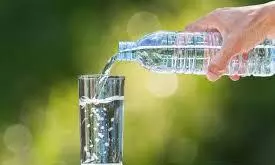
One-liter water bottles have 240,000 plastic fragments, says study
text_fieldsAn average one-liter bottle of water contains approximately 240,000 plastic fragments.
A new study is shedding light on a previously underestimated issue of plastic pollution in water sources.
The study, featured in the Proceedings of the National Academy of Sciences, delved into the realm of "nanoplastics" - particles smaller than 1 micrometer, largely unseen in prior investigations. These tiny plastics, not previously accounted for in assessments, were found to be present in bottled water, raising concerns about the potential health hazards associated with plastic contamination.
Traditional studies focused on "microplastics," ranging from 1 to 5,000 micrometers, failing to detect nanoplastics, which pose a graver threat as they can penetrate human cells, enter the bloodstream, and affect organs, potentially impacting unborn babies when passing through the placenta.
Using a pioneering microscopy technique and a sophisticated algorithm, researchers examined 25 one-liter bottles of water from prominent US brands. The investigation revealed an astonishing count of 110,000 to 370,000 minuscule plastic particles per liter, with 90% classified as nanoplastics.
Lead author Naixin Qian, a Columbia University graduate student, emphasised the study's significance in addressing the scarcity of knowledge concerning nano-level plastic pollution, calling it a groundbreaking tool.
Beizhan Yan, the study's co-author and environmental chemist at Columbia University, highlighted the study's role in unveiling the previously unexplored realm of nanoplastics, enhancing understanding in a field that was previously obscure.
The researchers analysed seven prevalent plastic types, including polyethylene terephthalate (PET) and polyamide, often utilised in water bottle production and purification filters. Despite this, unidentified nanoparticles were also discovered, potentially indicating higher plastic prevalence in bottled water.
This revelation comes in the wake of global plastic production exceeding 450 million tons annually, contributing to environmental concerns due to the non-biodegradable nature of plastic and its fragmentation over time.
While plastic pollution remains ubiquitous, bottled water, previously identified to have higher microplastic concentrations compared to tap water, is now a focal point due to its potential to introduce plastic particles into the human body.
Future research by the co-authors aims to explore nanoplastic occurrences in tap water and snow samples from western Antarctica, aiming to comprehend the broader impact of these particles. Biophysicist Wei Min, another co-author, emphasised the urgency of studying nanoplastics due to their potential health implications.























